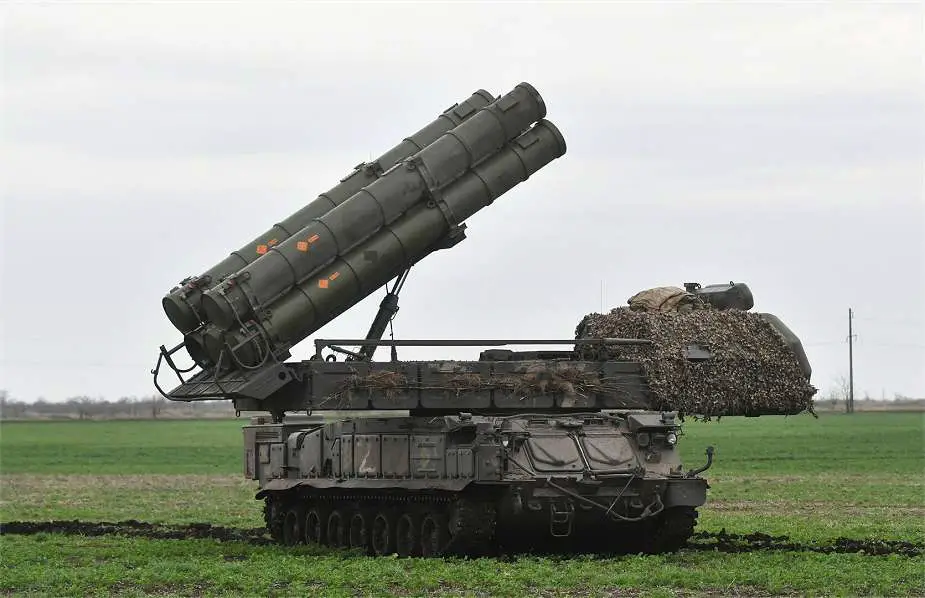Breaking news
Russia Plans to Double Anti-Aircraft Systems Deployment in Ukraine with New Missiles.
On April 23, 2024, Army General Sergei Shoigu, the Russian Minister of Defense announced that Russian forces deployed in Ukraine will be equipped with more advanced air defense missile systems, including the S-500, S-400, S-300V4, Buk-M3, and Tor-M2U. The decision underscores Russia's intent to enhance the protection of its troops against the increasing aerial threats encountered on the battlefield in Ukraine.
Follow Army Recognition on Google News at this link

The Buk-M3 is the latest generation of air defense missiles in the Buk series, currently deployed by Russian forces in Ukraine. (Picture source Russian MoD)
Citing Army General Sergei Shoigu, the Russian Minister of Defense, the new reinforcements to the air defense system for Russian troops in Ukraine will include state-of-the-art systems such as the S-500, S-400, and the upgraded S-300V4, along with the Buk-M3 and Tor-M2U air defense systems. These systems are renowned for their precision and capability to intercept a variety of airborne targets, offering a robust defense against potential aerial attacks.
The S-500 and S-400 are advanced Russian air defense missile systems designed to counter a wide range of aerial threats. The S-400 "Triumf" system, operational since 2007, is capable of engaging aircraft, UAVs, and ballistic and cruise missiles at ranges up to 400 kilometers, with the ability to track and target up to 160 objects simultaneously. Its versatility and high-performance make it one of the most formidable air defense systems currently in use. The S-500 "Prometey," a newer and more advanced system, further extends these capabilities. Designed to intercept ballistic missiles, it can also target satellites and stealth aircraft at even greater distances, enhancing its strategic defense potential. The S-500 is intended to integrate seamlessly with the S-400, creating a multi-layered defense network that significantly enhances air and missile defense coverage.
The S-300V4 is an advanced iteration of the Russian S-300 series of air defense missile systems, specifically upgraded for enhanced capabilities against a variety of aerial threats. As a successor to the S-300V3, the S-300V4 features significant improvements in range and precision, capable of engaging aircraft, cruise missiles, and even ballistic missile targets. The system has an increased interception range of up to 400 kilometers, and it includes the ability to simultaneously engage multiple targets with heightened accuracy. Notably, the S-300V4 also offers improved radar and detection capabilities, which enable it to counter sophisticated enemy tactics such as electronic jamming. The system is designed to form the backbone of a layered air defense network, providing robust protection for strategic assets and troop formations.
The Buk-M3, an advanced version of the Buk missile system, provides significant improvements over its predecessors, including increased range, accuracy, and the ability to engage a wider variety of targets. This system can destroy tactical and strategic aircraft, helicopters, cruise missiles, and unmanned aerial vehicles, as well as tactical ballistic and aeroballistic targets. The Buk-M3 is capable of tracking and engaging up to 36 targets simultaneously and can operate in environments with heavy electronic countermeasures.
On the other hand, the Tor-M2U is a highly mobile, short-range air defense system designed to protect against precision-guided weapons like smart bombs, aircraft, and UAVs at lower altitudes. It features enhanced electronic countermeasures resistance, improved fire control components, and can simultaneously track and destroy more targets than its predecessors. The Tor-M2U is particularly effective in intercepting small, fast-moving targets even under heavy fire and electronic jamming, making it a crucial asset for frontline defense.
General Shoigu emphasized that the strategic enhancement of air defense capabilities is crucial for safeguarding vital military and strategic installations. This includes command and control systems and the strategic nuclear forces, ensuring that Russia's critical defense infrastructure is well-protected.
The importance of Russia enhancing its air defense systems in the context of the ongoing conflict in Ukraine is driven by several key factors. First, the evolving nature of warfare has seen a significant increase in the use of drones, FPV (first-person view) technology, and loitering munitions. These technologies offer precision targeting and can be used to carry out reconnaissance and direct attacks on key assets, necessitating robust countermeasures.
Second, these new aerial threats are relatively inexpensive and accessible, making them a common choice for use in conflicts, including by non-state actors. Their capability to bypass traditional defense systems by flying at lower altitudes or using stealth technologies further complicates defense strategies.
Third, the protection of vital military and strategic assets, including command and control centers and strategic nuclear forces, is crucial for maintaining operational integrity and effectiveness. Enhanced air defense systems like the S-500, S-400, S-300V4, Buk-M3, and Tor-M2U are designed to intercept a diverse array of aerial threats at various ranges and altitudes, providing a comprehensive shield that minimizes vulnerabilities.
Lastly, improving air defense capabilities also serves a strategic deterrent role, signaling to adversaries the elevated risks of engaging in aerial assaults. This can potentially reduce the frequency of attacks and shift the strategic balance in favor of Russian forces. The introduction of advanced air defense systems is thus a critical component in adapting to modern warfare dynamics and ensuring the security and efficacy of military operations in Ukraine.
Defense News April 2024























